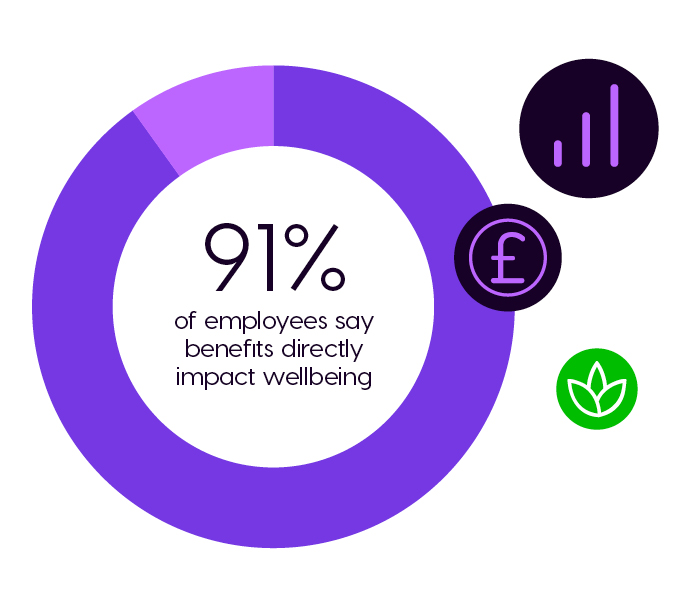
Employee Benefits, Global
Online benefits are the #1 way to get your value proposition to ALL your employees
14-06-2024
Our research showed that the biggest shift in employee attitudes over the last 12 months is in relation to benefits, where employees are taking a much greater interest in their employer’s offering. 61% of employees now say that benefits provision is very important when choosing an employer; this is top of their list alongside wellbeing support.
Benefits – and the technology used to deliver them – have become more highly sought-after by employees and an ever-more integral part of the employee experience and EVP.
Indeed, 48% of HR and Reward leaders say high-quality benefits tech helps them to show the value of everything they offer employees. This is the primary way organisations feel tech can support provision. Benefits are no longer just one element of the EVP; online benefits have become a central part of how the entire EVP is communicated to employees. And this evolution is partly a consequence of the dispersed nature of today’s workforce, as organisations look to digital channels to better engage their people – regardless of location.
As well as promoting the EVP and showing the value of everything they offer, our Evolution research found that there are a whole host of reasons why employers typically say they want to introduce employee benefits technology. From better understanding their people, to supporting the company values and purpose, and offering a consistent global experience, many of the objectives they shared highlight the desire to create better employee experiences for deskless and remote workers. For an increasingly dispersed workforce, employee benefits tech creates a sense of cohesion and consistency – and allows employers to engage ALL their people.

3 ways employers are using employee benefits tech to support the EVP
1. Providing wellbeing support
The benefits most valued by employees are almost exclusively related to financial and physical wellbeing. Employees are recognising a direct correlation between the benefits that are available to them and every aspect of their own, personal wellbeing.

By necessity, employees are looking to benefits to help with their financial wellbeing and provide protection against the impact of illness and injury. 65% of employees say that benefits are very important in supporting their financial wellbeing, compared with 53% in 2022.
Employers too use benefits as the main way to protect and enhance the wellbeing of their people – 90% of HR and Reward professionals believe that the benefits an employer offers directly impact employee wellbeing. Therefore, many employers are investing more in benefits, and extending protection previously reserved for office-based workers to their entire workforce.
In the UK, the three most valued benefit types are:
- Health insurance (31%)
- Lifestyle discounts (20%)
- Financial wellbeing & financial insurance (12%)
“Employee benefits are now the vehicle for organisations to deliver on the promises of their employee value proposition, and to differentiate their employee experience. People can apply for a job believing that an employer takes wellbeing seriously, but they only find out whether there is substance behind the company’s promises when something goes wrong and they need support. This is where benefits come into their own, demonstrating to current and prospective employees that their employer really is there to help and protect them.” – Gethin Nadin, Chief Innovation Officer, Benefex
2. Delivering choice and personalisation
Employees feel benefits provision could be more relevant and personalised – 57% of employees said this was the number one way the benefits experience could be improved. Employees want to feel cared for at an individual level. So, it’s no surprise that employers are looking to create more tailored and personalised experiences by using benefits technology and automation in a scalable way. And many employers are also adding a greater range of flexible benefits to their programmes, or introducing benefit allowances, to meet the diverse needs of their people.
Benefit allowances are growing in popularity because they can be offered universally, provide maximum choice and flexibility, and deliver the ultimate personalisation. Employees can choose (within your rules) to make absolutely anything a benefit: Netflix, Hellofresh, food on Deliveroo, spa treatments, sports equipment, books; anything you allow.
3. Creating a more consistent employee experience globally
Wherever your employees are based and however they work, the technology you use to deliver benefits can help create a unified global employee experience. However, only 26% of employees see their employee benefits experiences as excellent, and 47% want better technology to make benefits simpler and easier to engage with.
29% of global HR leaders are using global benefits tech to deliver a consistent global employee experience, and this figure is growing as more organisations look to create an exceptional experience for all employees – regardless of location. Even if the benefits on offer in each region differ, a centralised benefits platform ensures a consistent, recognisable and intuitive experience for people – which is especially important for global organisations with employees moving between regions.
Employees working remotely or in deskless roles can lack face-to-face time with managers and colleagues, so benefits technology plays an especially important role in getting all of the great things you do for them in front of them.
Here’s how Baker Hughes transformed the employee experience with global benefits technology:
Create an exceptional experience for deskless workers
Despite accounting for roughly 80% of the global workforce, deskless employees have rarely been able to get the same great experience at work as their office-based colleagues. Check out our report to see how to design benefits and rewards experiences to engage ALL your employees – wherever they work.


